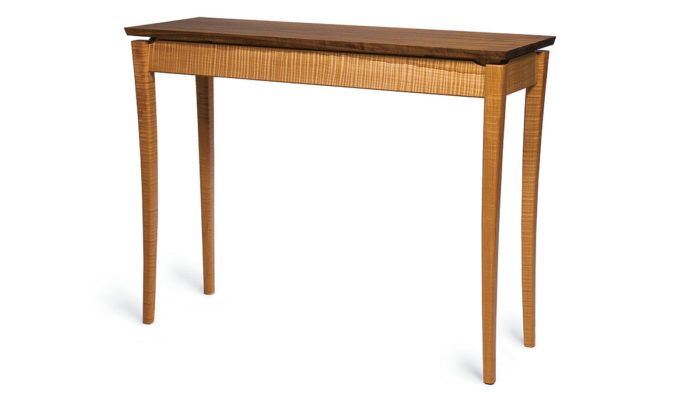Floating-top inspiration
Inspired by David Welter's floating-top techniques, Anissa Kapsales assembled a gallery of a few more pieces that can inspire you.
Tanka: a Japanese poem consisting of five lines, the first and third of which have five syllables and the other seven, making 31 syllables in all and giving a complete picture of an event or mood
Floating tabletop
Joy I feel, you rise above
Suspended on high
The base is your pedestal
Construction constraints be damned
by Anissa Kapsales
But seriously, we’ve all seen tables with tops that float. It’s a design element that can really change the way a table looks and feels. In the latest issue, David Welter shows his variation on the floating top, how to incorporate it into the design, and his construction methods.
If you’re thinking about trying this technique, here are a few more pieces that can inspire you. I’m also including some articles on how to attach tabletops because even with a floating top, you have to think about wood movement when you’re attaching the top to the base.
And if you’re in the mood to write some woodworking-related poetry, feel free to send in your work! Send all woodworking-related poetry to bdima@taunton.com.
Stylish Coffee Table with Sleek Lines by Jacques Breau
This coffee table draws design inspiration from the Danish mid-century period. Its floating top, pencil-roll edge, and angled legs add pizzazz. The use of floating tenons speeds construction of the angled joinery, while doubling up the mortise-and-tenon joinery adds strength to the base. Because the inside faces of the legs are flush to the inside faces of the front and rear aprons, the side aprons and the cross rails are the same length, which keeps the design simple.
Floating-Top Table – Michael Pekovich
This table could easily serve as a sewing table, a side table, a small writing desk, or even a TV tray. It’s a fast and straightforward project with some interesting joinery. Bridle joints attach the legs to the front rails, with drawbore pins holding everything together. Arched side rails and a floating tabletop add lift to the design. The bevel-edged top is made in two pieces and joined to the supports with a dovetailed cleat.
Curved-Leg Table by Don Kondra
Building “swoopy” furniture takes time, but it’s appealing, Don Kondra writes. In this article, he tells how to make full-size drawings, which he says is the key to finessing the joinery and accurately milling curved parts. He shows how to make templates to draw the curves and advises that you should acclimate the leg stock in your shop for a month before shaping. The joints for the legs are cut after shaping. Kondra rough-cut the top and eyeballed it to keep the overhang in proportion. And to finish the piece, Kondra used a simple tung oil/spar varnish combination. Side information describes an easy way to draw smooth curves using sticks and nails.
Bonus: How to attach a tabletop by Mario Rodriguez
While you cannot prevent a solid-wood tabletop from moving seasonally, there are several time-tested methods for attaching a tabletop that will allow you to control expansion and contraction and ensure the integrity of the table for its lifetime. In this article, furniture maker Mario Rodriguez shares six ways to secure a tabletop to allow for seasonal wood movement — traditional pocket holes, two kinds of metal clips, wooden blocks, tongue-and-groove blocks, and beveled cleats. He discusses design and construction of each and advises on their use.
Video Workshop:
 |
Fine Woodworking Recommended Products

Estwing Dead-Blow Mallet

Jorgensen 6 inch Bar Clamp Set, 4 Pack

Bessey EKH Trigger Clamps





















Log in or create an account to post a comment.
Sign up Log in